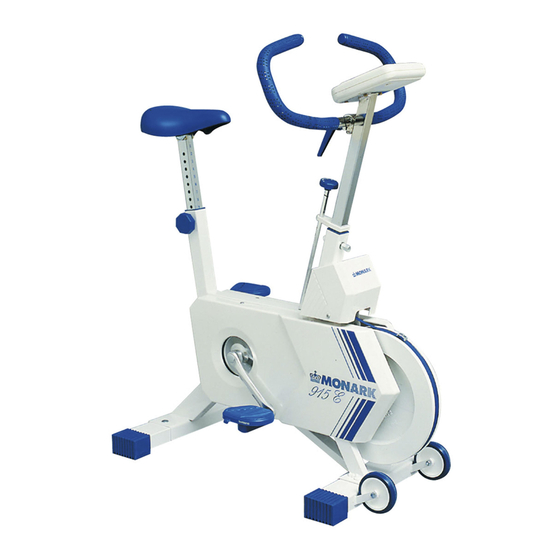
Table of Contents
Advertisement
Quick Links
Advertisement
Table of Contents

Summary of Contents for Monark 915E
- Page 1 MANUAL Exercise cycle 915E...
-
Page 3: Table Of Contents
Congratulations on your decision to purchase a product manufactured by Monark in Sweden. Monark has been the world´s leading manufacturer of high quality ergo- meters and exercise cycles for more than 40 years. CONTENTS Assembly instructions ...................... Operation instructions .................... -
Page 4: Assembly Instructions
ASSEMBLY INSTRUCTIONS The parts shown below are not assembled. Assembly instructions, see pages 5-6. Lever Saddle/Saddle post Electronic meter Handlebar/Handlebar stem Pressure washers Handwheel with tension screw Bolts Pedal, left hand Supporting tube, Supporting tube, back front Pedal, right hand Fig 1... - Page 5 ASSEMBLY INSTRUCTIONS cont. Place the support for the tension axle/screw as far down as it takes to push through the axle for the tension knob. Electronic meter Place the pressure washer with the smaller part in di- rection outwards inside the head tube. Joint contact Take the cable for the meter through the head tube.
- Page 6 ASSEMBLY INSTRUCTIONS cont. Tip the cycle forward and remove the transport block. Assemble the back supporting tube with two bolts and two nuts. See fig 4. Note! Use the accompanying spanner. Production number Fig 4 Tip the cycle backwards. Assemble the front suppor- ting tube with two nuts onto the two fixed bolts.
-
Page 7: Operation Instructions
OPERATION INSTRUCTIONS Exercise cycle 915E This testing cycle is provided with a brake system, which Tension power can be read in watts at two different speeds, 24 handwheel km/h (60 rpm) and 28 km/h (70 rpm). See fig 8. This model is also equipped with an electronic meter which –... - Page 8 OPERATION INSTRUCTIONS cont. If you hold down the button for more than two se- PROGRAMMING DISTANCE conds at normal display, all values except upper and Use the MODE key to advance to the DISTANCE lower pulse limit will be set to zero at the same time. function.
-
Page 9: Setting Of Work Load
SETTING OF WORK LOAD If you intend to exercise with a work load of 50 watts and a pedalling speed of 24 km/h (60 rpm), do as fol- Tension lows: handwheel Check on the RPM-display of the meter that you have achieved the correct pedalling speed. -
Page 10: Calibration
CALIBRATION Adjust the tension handwheel so that there is no ten- sion in the brake belt. Joint clamp Fasten a 4 kg weight (our part no 9000-211) around the joint clamp. See fig 11. When correctly set the weight – 4 kp – will be read on the scale for watts –... -
Page 11: Brake Belt Contact Surface And Brake Belt
BRAKE BELT CONTACT SURFACE AND BRAKE BELT Deposit of dirt on the brake belt and on the contact surface may cause the unit to operate unevenly. The brake belt contact of the flywheel surface should then be ground off with a fine abrasive cloth, see fig 13, and any dust be removed with a clean dry cloth Remove the brake belt before the grinding. -
Page 12: Chain
CHAIN 1/2” X 1/8” Check the lubrication and tension of the chain at re- Chain tensioner gular intervals. In the middle of its free length the chain should have a minimum of 10 mm of play. See fig 15. When the play in the chain is about 25 mm (1 inch) the chain should be tightened. -
Page 13: Crank Bearing
CRANK BEARING The crank bearing is long term greased and needs nor- mally no supplementary lubrication. If problem ari- ses, please contact your Monark dealer. REPLACEMENT OF THE FREEWHEELING SPROCKET Dismantle the covers and the chain. Loosen the axle nuts as described on page 12. -
Page 14: Replacement Of Sensor
Handlebar stem Handwheel with tension screw Frame Electric cable Joint contact Sensor Screw Fig 23 FLYWHEEL BEARING The bearings in the flywheel are lifetime greased and require normally no maintenance. If problem arises, please contact your Monark dealer. -
Page 15: Service
In the event of a defect in material or workmanship during the warranty period, Monark will repair or re- place (at its option) the product. Monark will do so at its expense for the cost of material but not for the la-... -
Page 16: General About Exercise
THE IMPORTANCE OF REGULAR EXERCISE The human body is built for action – not for rest. Once cally this is described as a reduction of the biological upon a time this was a necessity: the struggle for survi- age. Externally, you are your usual self. Internally, how- val demanded good physical condition. - Page 18 SE-780 50 Vansbro, Sweden. Tel +46 (0)281 594940. Fax +46 (0)281 71981 e-mail: info@monarkexercise.se www.monarkexercise.se...
















Need help?
Do you have a question about the 915E and is the answer not in the manual?
Questions and answers